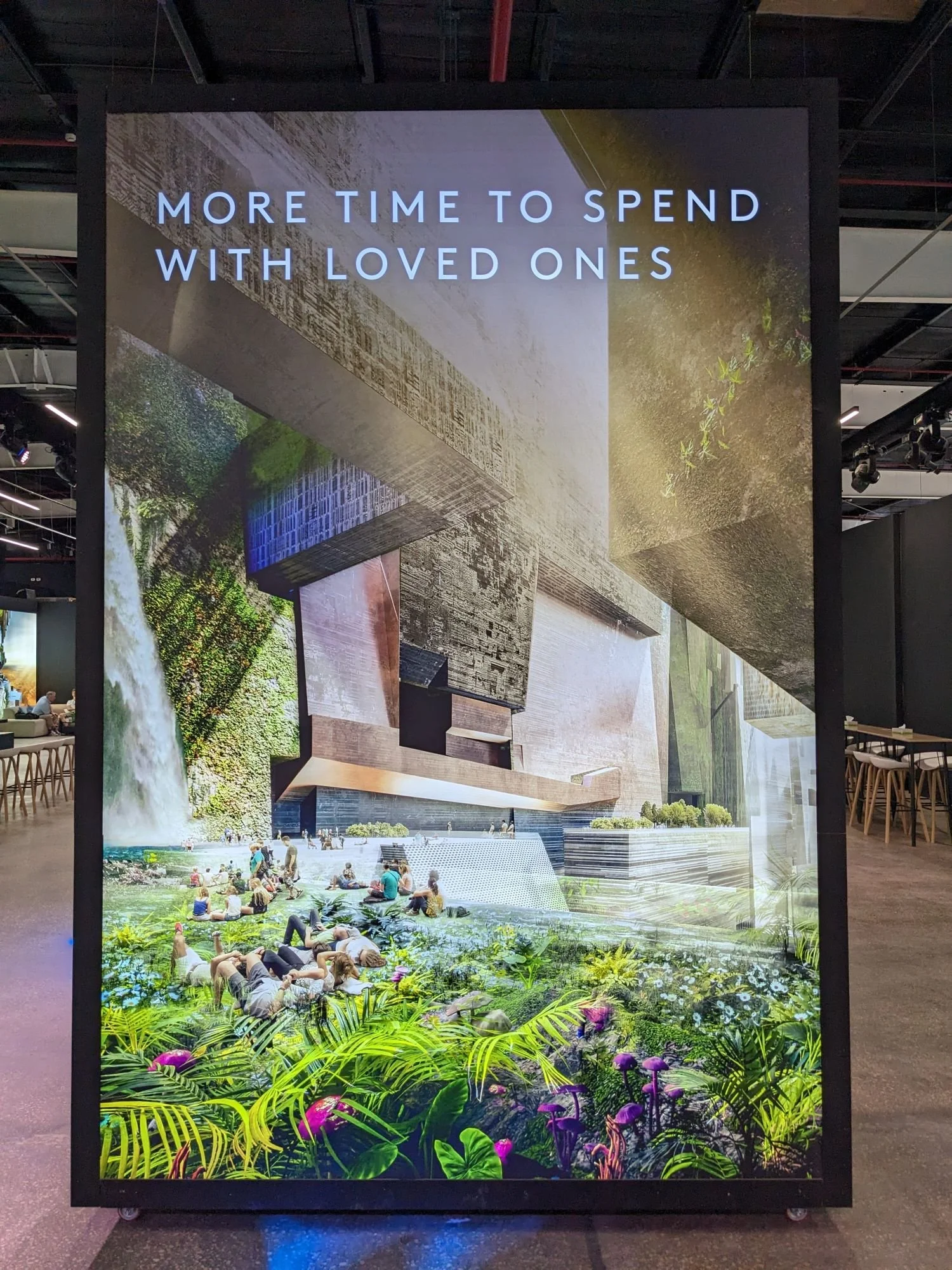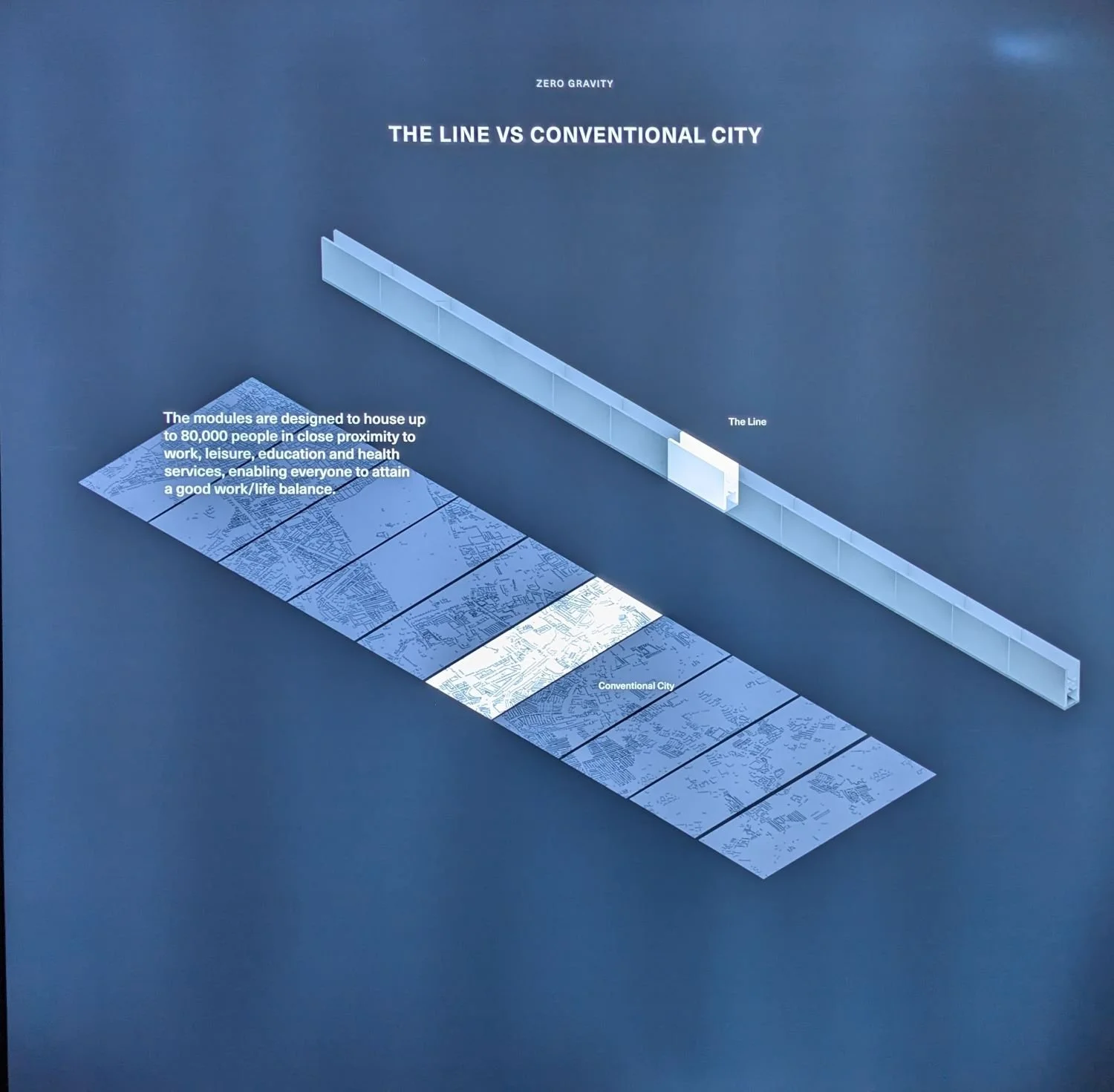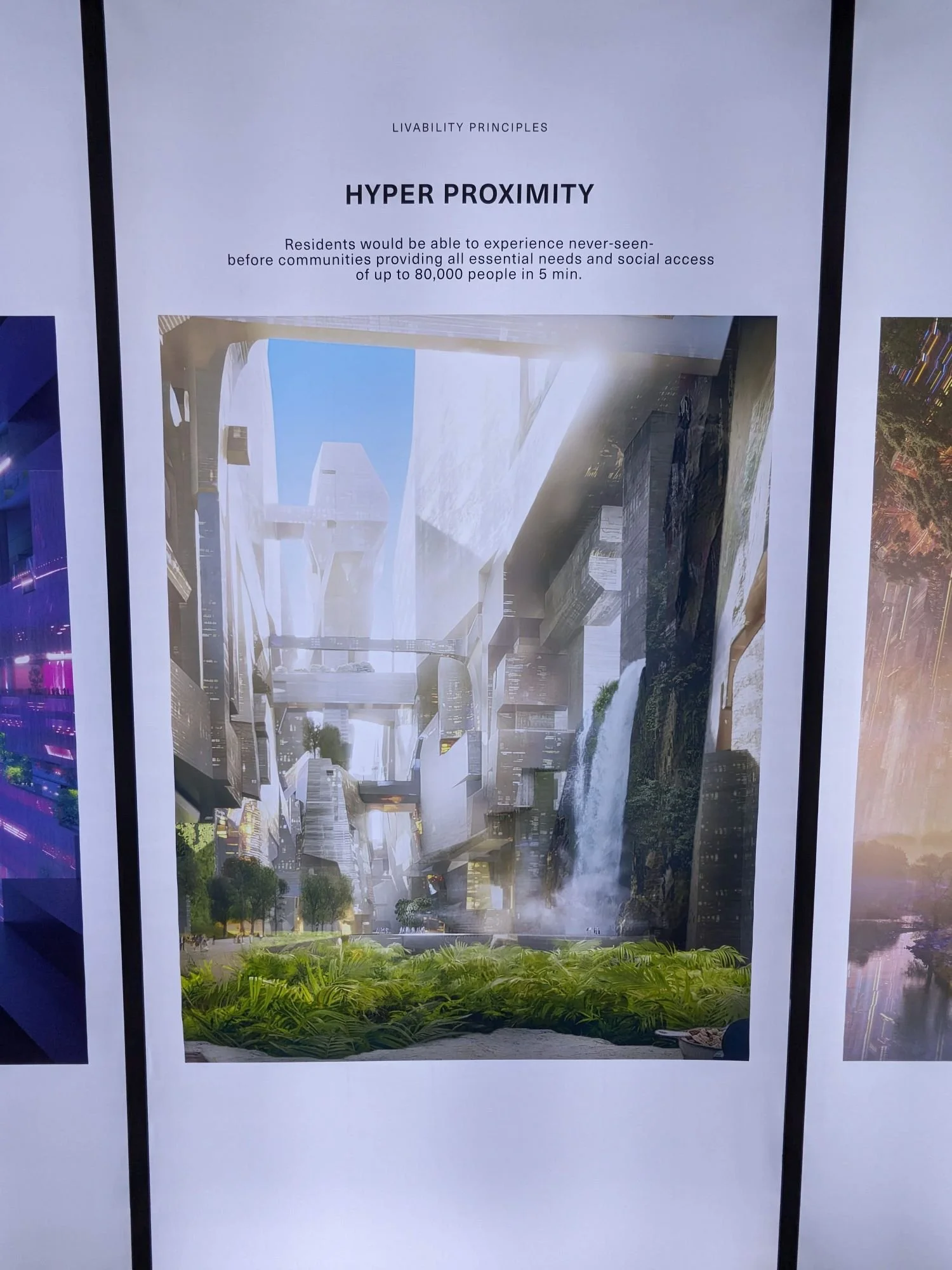The City of Dreams and Friends But You Still Have to Go to Work
The Line of Saudi Arabia
Maybe you heard of this already, but they are building a new kind of city: a singular line that will cut across the near-total distance of Saudi Arabia and accommodate 8-9 million people named The Line. It is a tremendous idea and also possibly the best example I can think of how deeply having money can affect a mindset.
In the next city over from Riyadh, Diriyah, there is an exhibition, The Line Experience, where you can explore and learn about the scope of the project, the intentions, and the process there. The project truly is tremendous.
But what I found most amazing was how they talk about The Line.
“More Time to Spend with Loved Ones”
The gallery opened into a massive waiting room at the front after a desk for checking tickets. There were couches and standing bars for, presumably, waiting. There were photographers to record your first impressions.
In the waiting room, there were massive pillars with images about what The Line would look like on the inside. It was astonishing, truly, but I was stopped by these mantras or goals:
Environmental solution to urbanism
Clean air for everyone
Unparalleled access to nature
More time to spend with loved ones
Ecology unbound and urbanism to its optimum level. Also, friends? I’ve never heard of a city planned around making new friends or seeing your friends. When I think of friends and cities, I’m either thinking of the uphill battle against southern Californian urban mazes to get to your friends or of DC where a functional metro system will get you pretty far.
We moved into the exhibit.
The Shape
The first room showed us the genius of this idea, its shape. They showed how the line shape of a city like this is the best way to address the pressures of a city and what it does to the environment, both ecological and socially. There were giant movies of cities of similar populations shown reformatted as a line. There was one of LA. I captured it on video. As the graphic circled around southern California, it showed the full reach of LA county. Suddenly, the cityscape starts to pixelate and then rapidly move to realign and spread out as a line that extends up and down the coast, clarifying one of the main advantages of The Line is that the natural environment around a city is less disturbed and in fact able to thrive.
Suddenly, southern California was not a desert but a lush green land. I think some of the sci-fi makes its way in here. I don’t think it’s understood that most of the water that LA needs to continue comes from a few states over in Colorado and without that massive intake, the area would remain in true form as a simple, beautiful desert. But, ok, The Line will make it a green space.
Liveability Principles
We made our way through sections of the city represented as installation art, spaces you could enter to more closely behold the dream. We passed through the marina they want to make at the one end of The Line that jets out over the Red Sea.
Later, there was a room for tables of light with images on them, artist renditions of what sections of The Line would look like. There could have been 30 of them in this room. At the front were larger, vertical towers of light listing what they called “Livability Principles.” Listen to the words here:
Zero gravity Urbanism - the 3-dimensional organization of building assets and public realm allowing people to live in a constructed vertical topography.
Hyper Proximity - Residents would be able to experience never-seen-before communities providing all essentials needs and social access of up to 80,000 people in 5 min.
Unfamiliar Relationships - The Line will leverage the 3-dimensional organization of assets and the lack of deprioritization of transport infrastructure to allow for functions to intersect and for unexpected synergies to be created.
Unusual Morphology - Assets can now take different form as they need only to respond to the human need and to elevate the human experience.
Ubiquitous Public Realm - Green and curated public space will serve as a glue between buildings at height. It will be everywhere and accessible to all.
Multiverse - the potential to move between different parts of a 9M population city in 20 minutes or less. This allows the city to behave in its offering in a sway that is closer to the digital world.
Walkability - The Line promotes walking as it provides access to all essential services and needs within a five minute journey. The walking city eliminates the need for personal transportation and promotes serendipitous social interaction and a healthy lifestyle.
Microclimate - Interlaced structures allow for subtleties of shade and light, with a temperate climate throughout and microclimates at different levels. Natural green spaces are threaded through the city at every level.
Zero Gravity. Hyper Proximity. Assets. Multiverse. Human experience. Serendipitous social interaction.
These are boundless, additive words that stir excitement and wonder. Who wouldn’t want a place like this, whatever some of this means? The promises are gigantic here. Also something directly out of science fiction.
Consistently, this line makes the promise of connecting people and promoting a healthy lifestyle. I think of one of the posters at the beginning of the exhibition. It read:
“The modules are designed to house up to 80,000 people in close proximity to work, leisure, education and health services, enabling everyone to attain a good work/life balance.”
Since we are still partially in the realm of sci-fi, it’s fascinating that in this utopia there is still work.
The Line and The Lux
When we had the chance to chat with Saudis we asked about The Line. It was an incredible example of belief in action. Often we were faced with a firm response of “yes, we will do it” in their voice and eyes. The power of belief deserves respect. Belief is truly limitless with deep wallets.
What does this city want? Like the Lux, it wants to cherish my valuable time. Its purpose is such that I could have everything I want and with no downsides or cost to this (there was also no trash in the artistic depictions of life in The Line). The ecological cost of my social needs (to commute, to visit friends, to take leisurely walks) are all neutralized in their cost by the structure of this place. The time-cost of going to meet my friends is also minimized, and it is apparently frictionless to make new friends in The Line. These are good things. I must confess a sense of inspiration from the scope of this. I want this to work.
These are worthy things to pursue. Shout out to anyone who already has a 5-minute commute to work, but that would be a nice thing. Even then, is that really the solution to having more time to do things in our life, a short commute? (It’s not-not a solution, but it seems a 4-day work week would get us there faster.) It’s understandable how “up” would be a less damaging presence than “across” in terms of building cities, but have I mentioned that the outer walls of this city are basically giant mirrors? What would happen if the heat and light from one of the hottest places on earth is reflected and shot elsewhere?
We reflected on this exhibition later in the day. One of us pointed out how easy it would be to dismiss these ideas and the plan here. Maybe it won’t work out like they say after all. Hopefully, though, this city will spur on a new way to think about the problems we are facing. I can accept this. There will be problems as this develops, but I suspend my disbelief.
More soon,
Trevor
Now-reading affiliate links:


